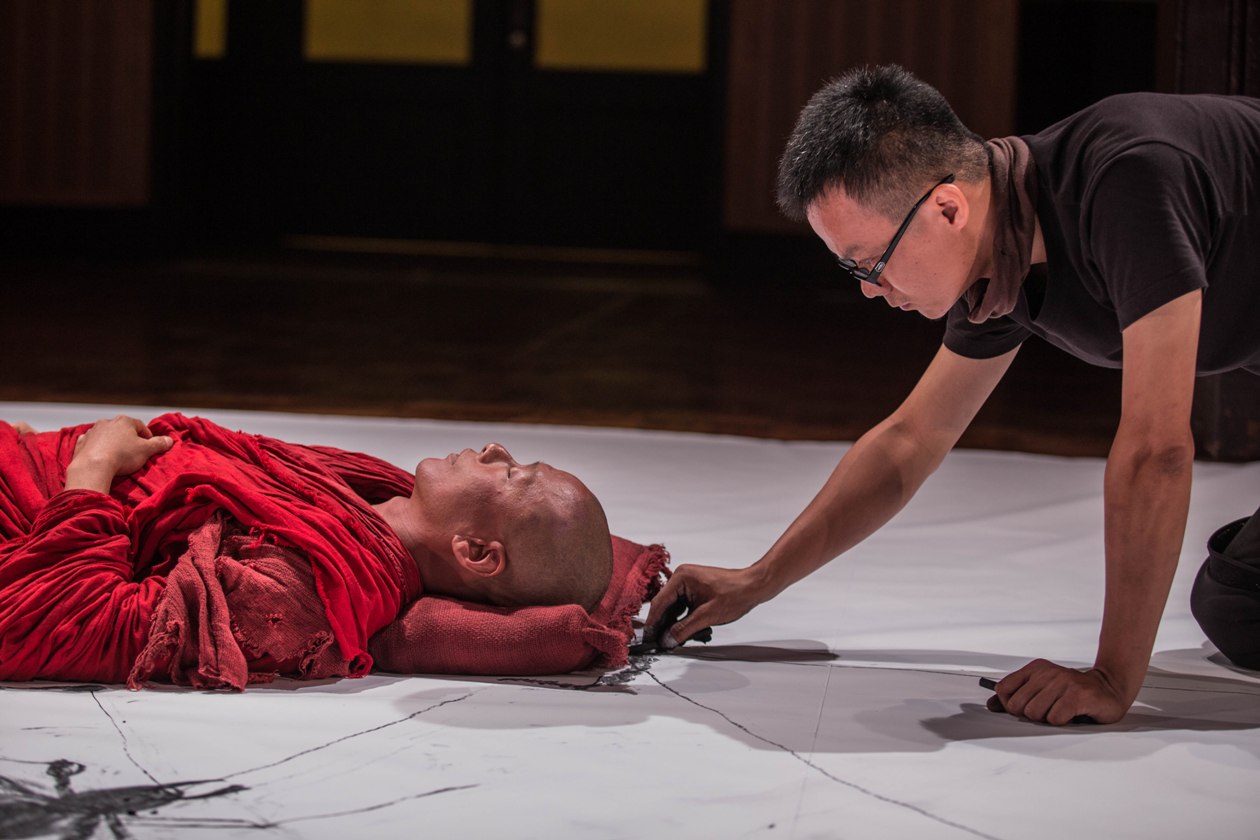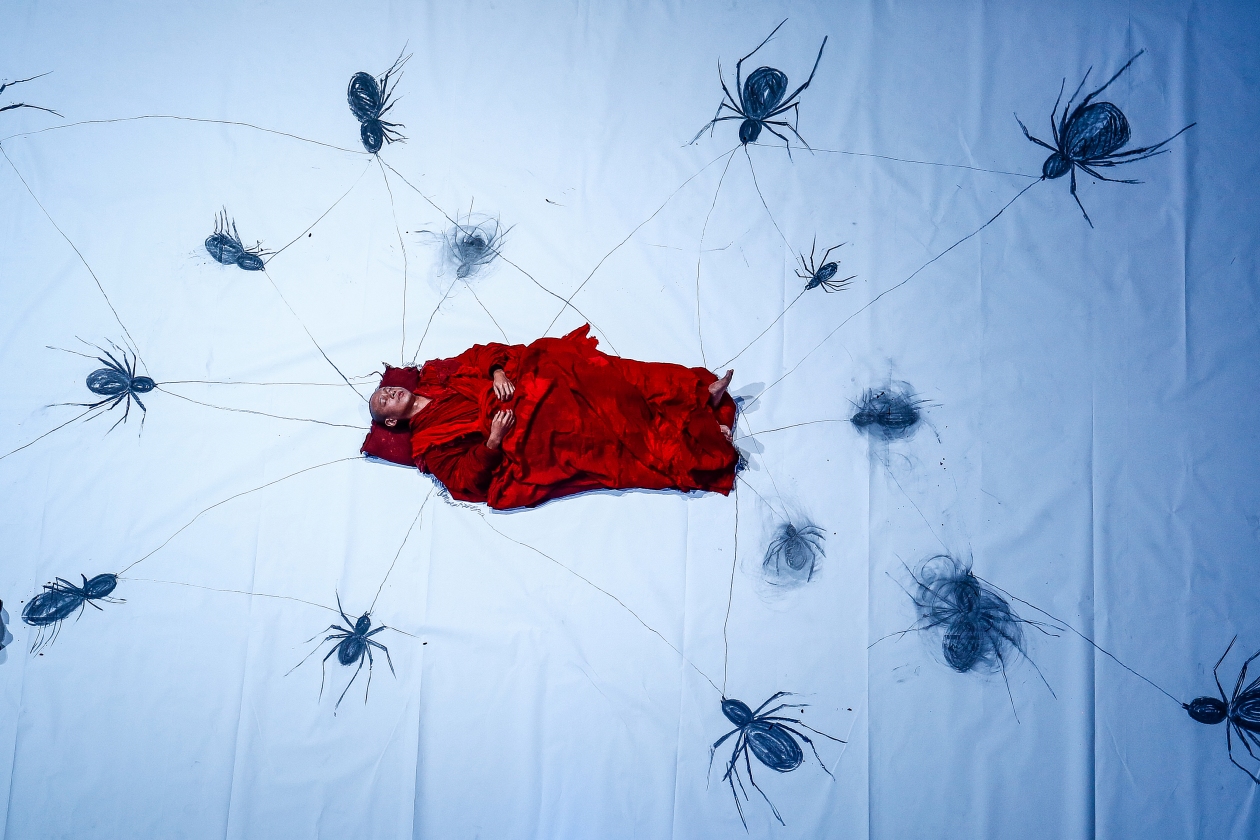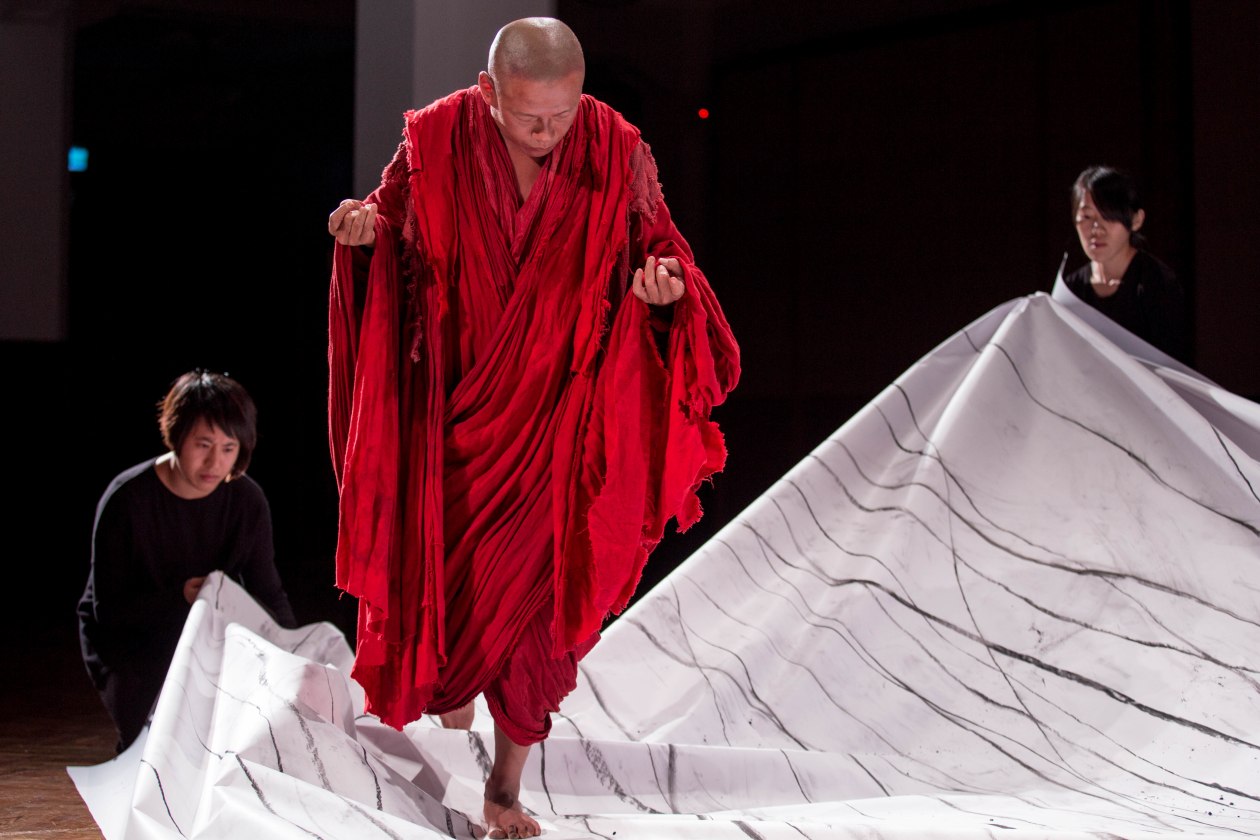《玄奘》為應布魯賽爾、維也納、臺北、光州四個城市藝術節邀請所做的全新創作。以李康生的慢走表演來演繹一千四百年前唐玄奘西天取經的刻苦精神,無故事情節,只有日常生活的動作,全在舞台上一張白紙上完成。藝術家高俊宏在白紙上用炭筆作畫,畫了玄奘的夢,也畫了玄奘的旅程,最後又把一切摧毀。
觀眾被安排在高處居高臨下的看,看那巨大的白紙如何被完成一幅畫以及台上一個又一個的動作,一切都在緩慢中進行,只聽到紙和筆接觸的聲音、餅屑掉落在紙上的聲音以及觀眾彼此的呼吸。
蔡明亮 TSAI Ming-Liang
1957年出生於馬來西亞,為台灣新電影運動以來最具代表性的電影導演之一。1994年以《愛情萬歲》獲得威尼斯金獅獎,奠定世界影壇地位,自此獲獎與邀約不斷。2009年作品《臉》成為羅浮宮首度典藏電影,創下藝術電影的標竿與典範;其他作品如《青少年哪吒》、《河流》、《洞》、《你那邊幾點》、《天邊一朵雲》、《不散》、《黑眼圈》、《郊遊》等都獲得國際重要電影獎項肯定。近年來亦積極參與藝術與跨界創作,於台北、威尼斯、上海、名古屋等地推出展演。
Born in Malaysia in 1957, TSAI Ming-Liang is one of the most prominent film directors of the new cinema movement in Taiwan. In 1994, his film Vive L’ amour was awarded the Golden Lion award at the Venice Film Festival, and this helped establish a place for him in the world of international film. In 2009, Face became the first film to be included in the collection of the Louvre Museum’s “Le Louvre s'offre aux cineastes.” It has since become the benchmark for films venturing into the world of art galleries. Tsai’s films, such as Rebels of the Neon God, The River, The Hole, What Time Is It There?, The Wayward Cloud, Goodbye, Dragon Inn, I Don't Want to Sleep Alone, Stray Dogs and more, have won worldwide recognition at significant international film awards and festivals. In recent years, TSAI Ming-Liang has also moved on to installation art. His works have been well-received in Venice, Shanghai, and Nagoya.
蔡明亮
李康生
高俊宏
王佳惠
葉昇伊
王雲霖
陳聖豪
洪伊君、何睦芸
張鐘元
林盟山
臺北市中山堂光復廳
關鍵字
- 裝置藝術
- 繪畫
- 劇場
- 金剛經
- 心經
- 炭筆
- 宗教
- 行走
藝術家談作品
好像剎那間,有個人在精神上跟我一致。
蔡明亮:「玄奘這個人可能跟我心裡有塊東西相呼應,比如說往一個方向踽踽獨行、不太理會別人的想法,與出走的概念...一個人孤獨走過那片沙漠,如何面對好像永遠不變的風景,跟那些描述,跟我心靈上的某些層面非常貼近,好像剎那間,有個人在精神上跟我一致。」
評審談作品
穿越了行動與裝置藝術、繪畫與劇場,走出了類型限制與文化圈限,也讓人見到了李康生與高俊宏的卓越演出。
入圍理由 Reason for Nomination
固然是蔡明亮的劇作,但穿越了行動與裝置藝術、繪畫與電影,也是先前影片《行走》與劇場《只有你》之後的綜合體,《玄奘》走出了類型限制與文化圈限,也讓人見到了李康生與高俊宏的卓越演出,都是值得喝采的。它體現了蔡明亮關注的個體慾望的政治性,影像豐富寓意,肢體動作在自然狀態與設計中達到渾然天成的結合,游刃於自我心境、古代敘事的想像與當代人的精神焦灼而有餘,在當代台灣電影導演中,無疑是藝術視野最全面、深具跨域能力的創作者。提名觀察人 ─ 陳泰松
This is a work by TSAI Ming-Liang, but it transcends action and installation art, painting or film. It is an amalgamation that follows his earlier film Walker and theater production, Only You. The Monk from Tang Dynasty departs from categorization and cultural boundaries. Exceptional performances by Lee Kang-sheng and Kao Jun-Honn are both worthy of accolade. The work embodies TSAI Ming-Liang’s concerns about the politics of individual desires. Images rich in allegory, and physical movements that are a heavenly combination of nature and design maneuver freely in the psyche, surpassing the combustion of the imagination of ancient narratives and the spirit of contemporary man. Among contemporary Taiwanese film directors, he is undoubtedly a creative force whose artistic vision is the most comprehensive with a depth of interdisciplinary strength. Nominator: CHEN Tai-Song
年度入選獎得獎理由 Jury’s Statement on Award Winners
《玄奘》以極簡的舞台、色彩與劇場元素,緩慢鋪展虛與實、顯現與隱無之間的無盡轉換。畫師以身體在場的方式進行繪畫,並以不同的手感符號,凸顯炭筆與白紙的物質構成,修行者以身體在場的方式,行住坐臥,貼擠日常與無常,成功展現時間在靜默劇場空間中的流經。此劇場作品展現了蔡明亮一貫的慢動作與老歌懷舊風格,以最貼近「現實」的方式,給出最魔幻的「真實」與最敏感的「寫實(時)」。與此同時,此劇場作品更精彩帶入了紙的新元素,可畫可坐,可折疊成蒲團,可縐摺成山巒,讓紙給出了充滿當代「多摺性」空間感性的無盡可能。
《玄奘》穿越了行動與裝置藝術、繪畫與劇場,走出了類型限制與文化圈限,也讓人見到了李康生與高俊宏的卓越演出。
With minimalist staging, color, and theatrical elements, The Monk from Tang Dynasty gradually unfurls the virtual and the real, and reveals their infinite conversions within nothingness. The artist is physically present to paint on site, using different tactile symbols to highlight the material structure of graphite and paper. The meditator is physically present to meditate on site, opposing the quotidian with the impermanent, and successfully demonstrating the passage of time in the silence of the theater space. This theater performance showcases TSAI Ming-liang’s signature slow, nostalgic style that presents a highly magical “reality” and a sensitive “real(time)ism” through an approach closest to “actuality.” The work brings in the element of paper that can be painted on, sat on, folded into a futon, or crinkled to resemble mountain peaks – imbuing paper with the endless possibilities of contemporary manifold perceptual space.
The Monk from Tang Dynasty traverses action and installation art, painting and theater; it transcends the limitations of category and cultural boundaries, and showcases the stellar performances of LEE Kang-sheng and KAO Jun-Honn.







